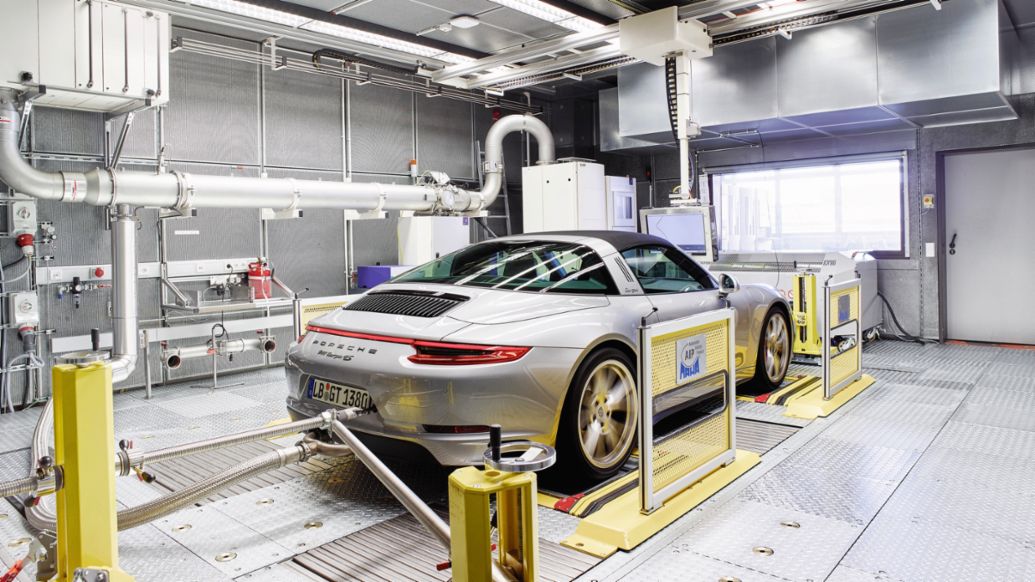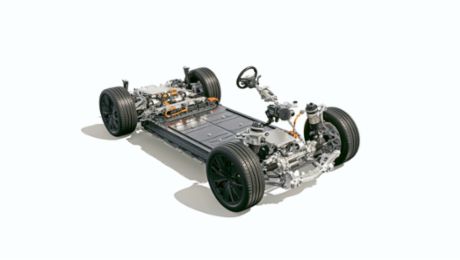On-board diagnostics (OBD) monitors the functionality of exhaust-related components over the life of the vehicle. To do this, test routines are implemented in all relevant control units of the vehicle and run while the vehicle is in motion. If an electronic control unit (ECU) returns implausible feedback, a corresponding code is stored in the OBD error memory of the ECU—for example if AFR sensor no longer correctly detects the oxygen content in the exhaust gas and the engine control unit then changes the combustion parameters. At the same time, the yellow malfunction indicator light in the cockpit flashes.
OBD originated in the United States: It was introduced in California in 1988 and throughout the US in 1994. Two years later, stricter emissions limits led to the more powerful OBD II system still in use today, which monitors emissions more precisely, includes other components in the check, and offers more detailed diagnostic options for workshops. OBD became mandatory in Europe in 2001, but with partly different requirements than in the US. In particular, emissions limits and measurement cycles differ significantly. Other regions such as China followed suit in subsequent years.
OBD was first introduced in California in 1988 and throughout the US in 1994. It has also been mandatory in Europe since 2001. China and other regions followed suit in subsequent years.
At Porsche, the checking of the OBD system for a new vehicle model is divided into three steps: firstly, quality assurance tests while the vehicle is still being calibrated; secondly, type approval tests in the so-called OBD demo phase as a compulsory prerequisite for approval; and thirdly, after the start of series production, a comprehensive examination of all potential OBD fault memory entries on vehicles from current production. Throughout all phases, Porsche Engineering and Porsche AG draw on the partnership that has grown over many years. “As a rule, we start checking the OBD calibration about six months before the start of production. If the tests reveal any abnormalities, we analyze the causes and suggest possible corrective measures,” says Dr. Matthias Bach, Senior Manager Engine Calibration and Mechanics at Porsche Engineering, under whose purview on-board diagnostics falls.
Coordination with certification authorities
In the OBD demo phase that follows, it is demonstrated that the vehicle’s OBD system complies with legal requirements. To this end, Porsche AG coordinates test series with the certification authorities in the individual regions around the world, which the experts in Porsche Engineering’s testing department then work their way through. “We cover 145 markets, ten of which have individual certification procedures,” says Thomas Rauner, Director of the Homologation Powertrain Department at Porsche AG. The different emissions laws, test cycles, and OBD requirements make development and testing extremely complex. A recent example is China, where the China 6b standard, which will be adoped in 2023, stipulates demanding OBD test conditions. “Unlike in the rest of the world, a positive test report will then no longer be sufficient in China to certify a new vehicle model. Rather, the OBD test must be carried out on site and under the supervision of the authorities,” explains Dr. Sebastian Rüger, who is responsible for OBD certification at Porsche AG, among other roles.
3,500 possible fault codes from the chassis and powertrain areas exist in hybrid vehicles.
As Porsche China’s exclusive strategic partner, Porsche Engineering supports on-site certification by providing technical services such as conducting the test series. Porsche AG is responsible for coordinating the test results with the respective certification authorities. “Thanks to close cooperative relationships and continuous exchange of information between the colleagues of Porsche Engineering in China and Germany as well as Porsche AG, we are able to implement the approval of the vehicle model on a tight timeframe in the process,” says Rauner.
For the OBD type approval tests of a new vehicle model, Porsche Engineering carries out up to 80 test runs on the dynamometer, recreating various emissions-relevant events such as a damaged lambda sensor line. For example, the engineers install specially prepared components in the vehicle or simulate predefined fault cases. To simulate the wear and tear of many years, they also use components such as catalytic converters that have been subjected to an artificial aging process.
In addition to legal requirements, the ever-increasing number of electronic systems in the vehicle is also leading to greater OBD complexity. OBD not only monitors individual components, but also checks entire functional sequences, including potential cross-influences from other vehicle systems.
“We cover 145 markets, ten of which have individual approval procedures.” Thomas Rauner, Director of the Homologation Powertrain Department at Porsche AG
This also includes control units that could indirectly influence emissions in the event of a defect, for example for Adaptive Cruise Control (ACC), Porsche Stability Management (PSM), and the Remote Park Assistant, which automatically parks the vehicle. “As part of the OBD verification tests required by the authorities, the Product Vehicle Evaluation, we have to prove that the emissions-neutral compensation measure is carried out correctly—in other words, that it no longer has any influence on the vehicle’s emissions behavior,” says Rüger. “Experts refer to this as an Emissions Neutral Default Action, or ENDA for short.” The resulting testing effort is correspondingly high: “In modern hybrid vehicles, we have up to 14 ECUs from the powertrain and chassis areas with around 3,500 possible error codes,” says Bach.
Simulation of errors
These have to be verified within a period of up to six months after a vehicle goes into production. To save time and costs, Porsche Engineering relies almost exclusively on the simulation of faults. “Instead of installing and removing defective components for test bench examinations or road tests at great expense, we modify the respective sensor signals or messages in the vehicle’s electronic data system,” explains Bach. This requires an in-depth understanding of the component and its function in the overall system, which Porsche Engineering, as an OBD service provider from the very beginning, has gained in countless development projects. “Our strength is our expertise in the areas of complete vehicles and testing. On this basis, we have developed our own testing and simulation tools, which can be used to reproduce around 95 percent of the defects in the OBD system,” explains Bach.

For example, the function of the throttle valve actuator is simulated externally during engine operation, so the throttle valve installed in the vehicle can be tested separately. In order to display the desired fault memory entries for the injectors, specially developed software is used to change the injection quantity of the injectors within a very fine range. “When it comes to simulating networking faults in the electronics architecture, we are always up to date thanks to our strong cooperation with colleagues in development and can therefore present the appropriate test procedure as soon as new diagnostic functions are introduced,” says Bach.
“Our strength is our expertise in the areas of complete vehicles and testing.” Dr. Matthias Bach, Senior Manager Engine Calibration and Mechanics at Porsche Engineering
The result is an extremely fast and efficient OBD process. It is foreseeable that the resulting advantages will become even more important in the future, as stricter emissions standards, such as the Euro 7 standard currently under discussion, further reduce the permissible exhaust gas limits worldwide. Thus the spiral of OBD development continues to turn: new systems and functions enable lower emissions values, which are then tested again via the improved OBD. In addition, there are diagnostic tasks arising from the use of synthetic fuels known as e-fuels. “It can be assumed that electric cars will also have to pass an OBD test in the future,” says Bach with a view to the future. “It would then be about the condition of the powertrain and battery rather than nitrogen oxide or particulate emissions."
Info
Text: Richard Backhaus
Text first published in the Magazine Porsche Engineering, issue 2/2021.



.jpg/jcr:content/MicrosoftTeams-image%20(18).jpg)
.jpg)
